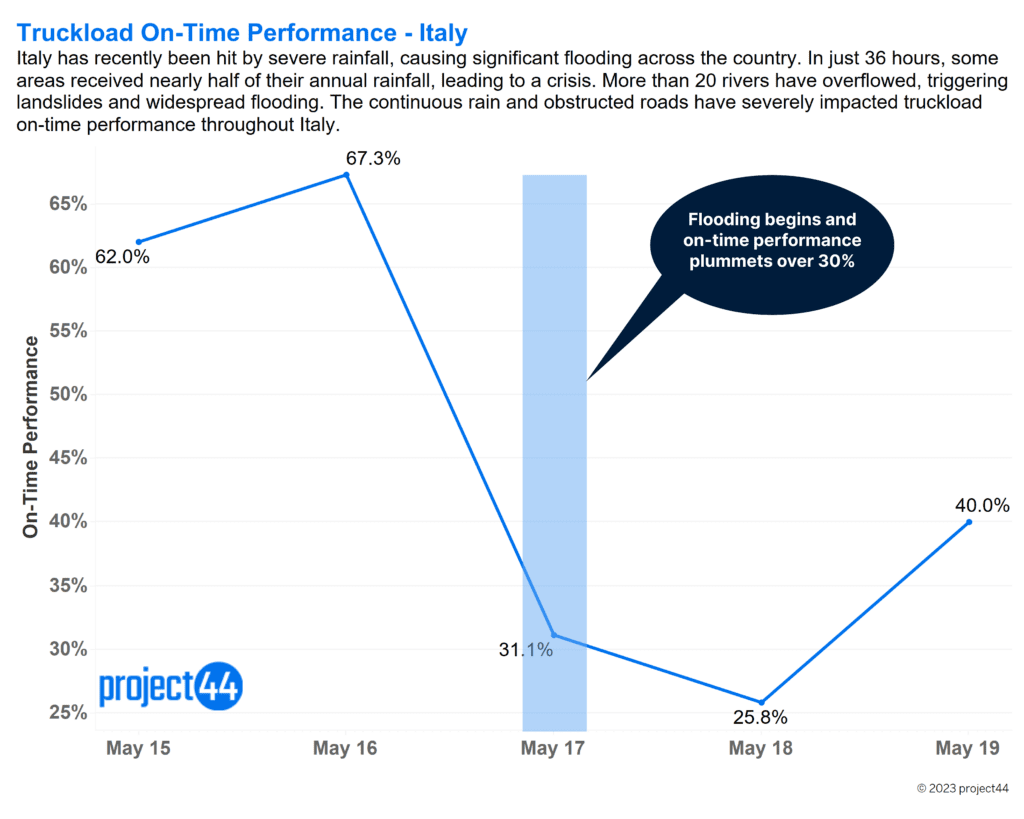The Emilia-Romagna area of Italy is reeling from the aftermath of devastating floods that have upended the lives of over 36,000 people and claimed the lives of 14 individuals. In just 36 hours, an astounding amount of rainfall, equivalent to six months’ worth, triggered widescale flooding and landslides. The resulting damage has left approximately 500 roads in ruins, creating formidable barriers for rescue teams and hindering aid delivery to the affected areas.
Truckload On-Time Performance
The impact of these floods is acutely evident in truckload on-time performance, a vital metric that measures the percentage of shipments delivered according to their scheduled delivery times. The data reveals a significant drop of over 30% in on-time performance between May 16th and 17th. Given the extent of infrastructure damage, it remains uncertain when truckload performance will return to normal levels, adding further complexity and uncertainty to the situation.

Potential Global Impact
When natural disasters strike, their impact often extends beyond national borders. The recent floods in Italy serve as a stark reminder of how interconnected and complex global supply chains are. While the floods themselves may not directly affect other countries, their ripple effects can have significant implications on various industries worldwide. In this article, we will explore the potential impacts of these floods on the global supply chain and the industries that rely on Italian goods.
1. Delays in Production and Transportation:
Luxury fashions, automotive parts, and delectable foods and wines—Italy is renowned for its exquisite craftsmanship and culinary delights. However, the floods are likely to cause delays in both the production and transportation of these goods. As a result, the market for Italian products may experience shortages. Furthermore, manufacturing sectors that depend on raw materials sourced from Italy could also face disruptions, potentially leading to further delays and shortages.
2. Increased Costs:
Supply chain disruptions often come at a cost. In the wake of the floods, various factors can contribute to increased expenses throughout the supply chain. For instance, companies may need to provide hazard pay to drivers navigating through flood-affected regions. Finding alternative suppliers that can fill the gaps left by Italian manufacturers may come at a higher price, as well. Moreover, rushed shipments—whether by truck or air—typically incur premium charges. As these cost increases permeate upstream, the prices of final goods are likely to rise, impacting consumers globally.
3. Operational Delays and Pressure on Ports:
Once the flood-induced delays in Italy subside, there is a possibility of an influx of shipments hitting the international market simultaneously. This surge in arrivals can cause operational delays, particularly in ports and the trucking industry. While the impact on countries like the United States might be minimal due to Italy not being a major exporter to the US, other nations such as Germany are more likely to feel the pressure. As ports and transportation networks grapple with the sudden surge, the smooth flow of goods may be temporarily disrupted.
Conclusion:
The floods in Italy serve as a reminder of the intricate web that forms the global supply chain. While the direct impact might be confined to Italian borders, the consequences reverberate across industries and nations. Delays in production and transportation, increased costs throughout the supply chain, and potential operational bottlenecks at international ports are some of the challenges that may arise. As we navigate the aftermath of these floods, it is vital for businesses and policymakers to assess the vulnerabilities in the global supply chain and work towards building resilience for a more stable and adaptable future.
Back to More
